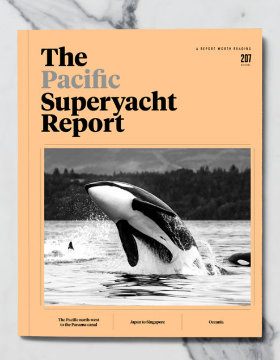Company Description
Claydon Reeves was set up in 2010 by James Claydon and Mike Reeves. The creative studio they have built shares the goal of delivering distinctive and unique designs through a client driven process. In the course of their careers the team has been involved in the design and build of a multitude of yachts between 40 and 100m at many of the world’ premier shipyards.
The designers have experience across a range of disciplines, from luxury interior and furniture design to automotive and yacht design. The founding members began their careers in the automotive arena and share a passion for understanding how things work.
This translates into designs that creatively and intelligently fuse style with the fundamentally practical.
The client is the catalyst for every project. Their wishes and visions are the basis of the creative process and design development. The relationship between client and studio has a huge impact on the project— a yacht is the beginning of a journey, an unforgettable experience for all parties involved and one that should be enjoyable.
“ translate our fascination of the designed world into elegant yacht exteriors with strong flowing lines. Although our passion is for pure and simple, we’ not afraid to challenge the staid and ordinary by introducing automotive and sculptural design elements. Our details are considered and practical never gimmicky or overtly ornate.”
— Reeves
List of core services:
• Exterior design
• Interior design
• Furniture design
Project Citadel
An Ultra Explorer capable of voyages into the most extreme environments.
Designed with a powerful and imposing stance to reflect its rugged functionality, Citadel is a floating refuge for its owner and guests as they criss-cross the world’s oceans.
Internally the volume is massive, with surprising features designed to allow the occupants the most dramatic views of passing seascapes. Bridge wings and courtyards are wrapped in glass as they overhang the hull below. The outside environment is cinematically framed by the slim pillared support structure of the main superstructure.
A large courtyard space on the stern of the vessel contains a lifting floor swimming pool with opening roof. Adaptable for any environment be it the freezing cold of Antarctica or the sweltering heat of the Indian ocean Citadel is a mobile command station for adventure.
An internal Moon pool allows the discrete operation of an eight-person submarine. This area is also dedicated to underwater exploration with a full dive club stocked with every conceivable underwater robot and drone.
Long-range, sustained autonomy is a priority for this concept with ample space for mission supplies and storage.
SPECIFICATIONS
LOA: 135m
Beam: 22m
Draft: 5.5m
Guest capacity: 22
Crew capacity: 50
Staff capacity: 8
Multiple helicopter capability
Tenders: 2 x 15m
Landing craft: 12m
Internal moon pool with submarine launch capability
Range: 10,500nm
Personality
Q: How did you become a superyacht designer and what or who inspired you into the industry?
As a child I was interested in anything mechanical—, boats, planes ... I bought my first premium boat magazine in 1989— opened my eyes to an amazing new world. Fast-forward 10 years to university, and despite my initial intention of becoming a car designer I realised the constant excitement of 60 fellow car enthusiasts diluted my desire to draw cars professionally. I changed direction and from my second year onwards I concentrated solely on boats.
Early inspiration was always the Oceanfast designs of Jon Bannenberg like Antipodean, Southern Cross III and Coral Island. Thunder A, from 1998, remains my favourite yacht.
Answer by James Claydon.
Q: Of the projects you’ worked on, which was your most challenging and why?
Each project inevitably comes with its own set of challenges. This can be working to refine intricate furniture design requests, optimising the accommodation from a hull form, designing a space for an on board pet, right down to the creation of a logo that will work successfully on the exterior of the yacht as well as on tableware, uniforms and stationery.
I think the sense of reward you get when these challenges have been solved is the reason most designers get out of bed each morning.
Q: How do you go about understanding a client and their wishes for a project?
It seems obvious but the only way to fully understand the wishes and needs of a client is to spend time with them. To create a yacht for a client you must find out who they are and what their unique philosophy is so that you can mirror this in the final design.
Whilst awareness of the client’ home de´ or the style of their current boat is invaluable, it is only when you can discuss specifics in person that you really understand the finer details required to deliver a design that truly satisfies all their requirements. What we would design for ourselves.










